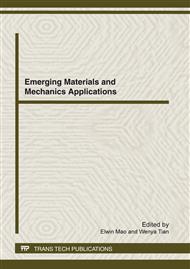[1]
Fang Wang, Wei Cheng Cui, Jeom Kee Paik. Residual ultimate strength of structural members with multiple crack damage[J]. Thin-Walled Structures, Volume 47, Issue 12, December 2009: 1439-1446.
DOI: 10.1016/j.tws.2009.07.013
Google Scholar
[2]
X.C. Zhang, C.J. Liu, F.Z. Xuan, Z.D. Wang, S.T. Tu, Effect of residual stresses on the strength and fracture energy of the brittle film: Multiple cracking analysis[J], Computational Materials Science, Volume 50, Issue 1, November 2010, P 246-252.
DOI: 10.1016/j.commatsci.2010.08.010
Google Scholar
[3]
T. Swift, Damage Tolerance Capability, International Journal of Fatigue[J]. 1994, Vol. 16, No. 1, 75-94.
Google Scholar
[4]
D. Y. Jeong, J. C. Brewer. On the Linkup of Multiple Cracks [J]. Engineering Fracture Mechanics, 1995, Vol. 51,No. 2, 233-238.
DOI: 10.1016/0013-7944(94)00267-l
Google Scholar
[5]
G. Labeac, J. Diamantakos, Th, Kermanidis. Crack Link-up for Multiple Site Damage using an Energy Density Approach [J]. Theorectical and Appkied Fracture Mechanics, 2005(43), 233-243.
DOI: 10.1016/j.tafmec.2005.01.007
Google Scholar
[6]
D. Broek, D.Y. Jeong, D. Thompson. Testing and analysis of flat and curved panels with multiple cracks[R]. In: Advanced Structural Integrity Methods for Airframe Durability and Damage Tolerance. Proc. FAA/NASA Int. Symposium, Hampton, 4-6 May 1994, NASA Conf. Publication 3274, 87-98.
Google Scholar
[7]
J. H. Kuang, C. K. Chen. The failure of Ligaments Due to Multiple-Site Damage Using Interactions of Dugdale-Type Cracks[J]. Fatigue&Fracture of Engineering Materials&Structures, 1998, Vol. 21, 1147-1156.
DOI: 10.1046/j.1460-2695.1998.00070.x
Google Scholar
[8]
Xiangyang Deng, John W. Hutchinson. Approximate Methods for Analyzing the Growth of Large Cracks in Fatigue Damaged Aircraft Sheet Material and Lap Joints[J]. Finite Elements in Analysis and Design, 1996, Vol. 23, 101-114.
DOI: 10.1016/0168-874x(96)89131-1
Google Scholar
[9]
R. Galatolo, K-F Nilsson. An Experimental and Numerical Analysis of Residual Strength of Butt-joints Panels with Multiple Site Damage[J]. Engineering Fracture Mechanics, 2001(68), 1437-1461.
DOI: 10.1016/s0013-7944(01)00027-3
Google Scholar
[10]
P.C. Paris G.C. Sih. Stress analysis of cracks[J]. Fracture Toughness Testing and its Application, 1965, ASTM STP 381, 30-83.
DOI: 10.1520/stp26584s
Google Scholar


